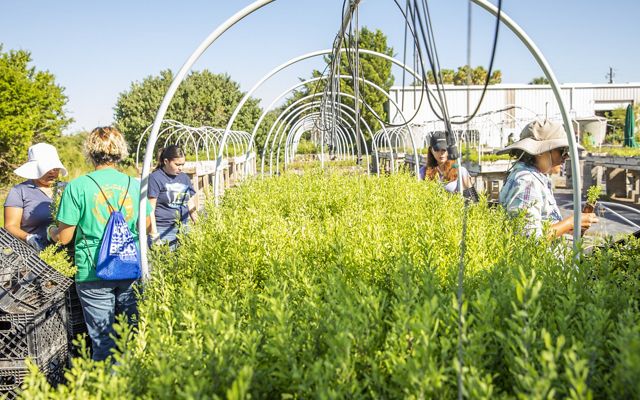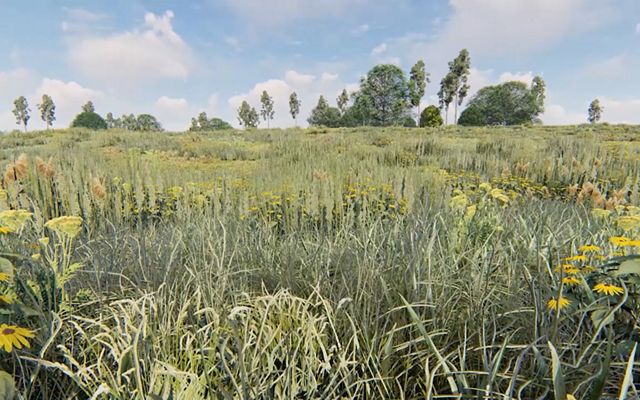Planting the Seed for Future Generations
Harnessing native seeds and ecological know-how to restore Texas’ prairies.
Prairies: The Backbone of Texas’ History and Culture
Ask someone from outside the state how they picture Texas, and their answer will likely include bar-b-que, cowboys, bluebonnets and rodeos. Yet this iconic Texas imagery is only a reality because our state was once covered in ancient grasslands—Texas’ heritage landscapes, intertwined with our identity and culture. After all, we wouldn’t have the Cowboys, Longhorns, Aggies, Mavericks, Spurs or Rangers without a strong connection to prairies and grasslands.
As these grasslands are increasingly impacted by urbanization, fragmentation and agriculture, it’s critical to understand how they’ve shaped our state’s economy and iconic culture—that intrinsic link between quintessential Texas and the landscapes that once thrived across our great state.

Threats Loom Over Our Hardworking Grasslands
Like Texans, grasslands are hardworking. As the climate changes, we can thank our prairies and grasslands for cleaning our water, helping to protect us from floods, mitigating air pollution and providing a home for biodiversity. They’re also robust—the shallow and deep roots that sink into our soil allow grasslands to withstand repetitive flooding, droughts and grazing. Hardy as these ecosystems are, however, they face major challenges.

As the state population rises, more land is converted to keep up with that growth. Because of this rapid urbanization, we’ve lost and broken apart our once-expansive Texas grasslands and the services they’ve long provided. Today, just one percent of Texas’ original native grasslands remain intact, putting enormous pressure on our natural resources and pitting our economic needs against the survival of this ecosystem. Furthermore, many of the crops Texas is best known for—cotton, hay and sorghum, for instance—are grown where native prairies once stood. And non-native grasses, flowers and other wildlife, if left untreated, can quickly invade these areas, changing the structure and makeup of an existing grassland.
Stewarding Native Grasslands for the Entire State
TNC preserves not only provide crucial protection for some of the best remaining remnants of native grasslands, they are living laboratories for harnessing the resources and knowledge of our land stewards to educate landowners, researchers from schools and universities, master naturalists and everyday Texans about the importance and function of these grasslands—and how we can make them work for people and the planet.
The road back for some of these natural landscapes begins with a single seed on one of our grassland preserves. This is multiplied across the hundreds of native plant species that enrich our diverse grasslands—and then multiplied again by millions of individual seeds for each species.


Our starting point is to identify a critical portion of land for protection, such as a prairie along the upper Gulf Coast. Once the land is secure, we work tirelessly to manage its plant communities to ensure their functionality. This means using tools such as prescribed fire to promote new growth and rare plant germination, invasive species treatments to avoid a takeover, mowing or mulching to manage woody plant competition—whatever the landscape demands. As those processes unfold, plants can grow and thrive, and a seed is produced—a seed that represents hope for restoring these lost landscapes.
And the positive impacts don’t stop at preserve boundaries—they reverberate out across the state. Land stewardship on a single grassland preserve can buoy declining wildlife populations, provide native seed for restoration in other communities and contribute to regional and urban resilience.

Prairie Restoration at Houston’s Memorial Park
TNC and Memorial Park Conservancy have teamed up to restore native prairie on half an acre along a powerline right-of-way, in part using seed source from our coastal prairie preserves along the Gulf Coast (Nash Prairie Preserve, Clive Runnells Mad Island Marsh Preserve, Texas City Prairie Preserve). The new Land Bridge and Prairie project at Memorial Park seemed a natural fit for TNC to help make this parcel the best possible representation of coastal prairie habitat for Houstonians to enjoy. This transformative, nearly 100-acre project is reuniting the north and south sides of the park by creating a land bridge over Memorial Drive, establishing a dynamic new community space and enhancing recreational opportunities for park users.

As part of the restoration project, TNC supplied thousands of pounds of seeds from its regional preserves to reintroduce native Gulf Coast prairie and wetlands to areas north and south of Memorial Drive. These efforts are restoring important habitats for pollinators and wildlife, helping manage stormwater in communities that deeply understand the power of severe storms and supporting the region’s overall resiliency. Additionally, a new network of trails is providing safe crossings for both people and wildlife.
Now complete and open to the public, the Land Bridge and Prairie serve as a beacon for a greener and more resilient future, one which distinguishes Memorial Park and Houston and promotes a richer appreciation for nature throughout the Bayou City community—cumulative benefits that will be felt over generations.


We Can’t Save Nature Without You
Sign up to receive monthly conservation news and updates from Texas. Get a preview of Texas' Nature News email.




